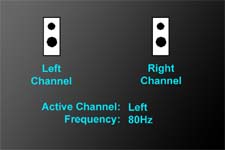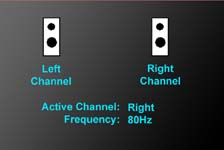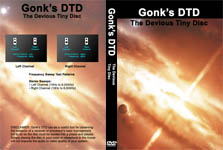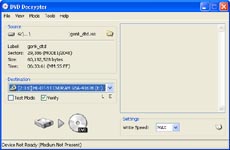
Gonk's DTD
DVD Image
(57.3MB)

Gonk's Audio DTD
CD Image
(10.0MB)

Gonk's DTD
Keepcase Cover
(2.5MB)

DVD Decrypter
Image File Burning Software
(880KB)
The initial concept was of a disc with PCM, Dolby Digital, and DTS tracks containing a separate chapter for each channel - so you could set the Dolby Digital title's third track to repeat and listen to the test tone sweep on the right channel. That concept would require the creation of not only the test tone but both a Dolby Digital and a DTS audio track. Since that was impossible with the resources available to me, I tried something else: making a PCM stereo track with the test tone in either the left or right channel, syncing those two tracks (one for left and one for right) to a pair of simple slide shows identifying the frequency, turning that combined audio and video into an MPEG-2 file, and authoring a DVD from that. It took an odd array of programs, but I was able to pull it off. The result is Gonk's Devious Tiny Disc, or as it's fondly know the DTD.
You may be wondering what use this devious tiny disc might be to you. Honestly, it may be of no use whatsoever. If you ever find yourself wondering exactly what is happening with your subwoofer and your other speakers at the crossover point, however, then you may have a use for the DTD. You can play either or both of these two test tones and observe how your receiver or surround processor steers the signal as the test tone travels up from 20Hz all the way to 6,000Hz simply by observing which drivers are moving in your sub and your main speaker. You can even get some idea of how your speaker's internal crossovers are designed by watching when the signal moves from one driver to another. I stopped the disc at 6,000Hz because the main purpose here was to look at bass management, but aside from some ultrasonic super tweeters (which generally operate above the 20,000Hz upper limit of human hearing) most speaker crossover networks have moved everything to the tweeter by around 6,000Hz anyway. It's devious, tiny, and occasionally even useful for the home theater hobbyist who really likes to tinker with his or her system.
The Devious Tiny Disc is available below as a downloadable 60MB ISO disc image, which can be burned to a DVD-R and played back on any DVD player. The DVD image can also be burned to a CD-R, but not all DVD players will recognize it as a DVD. (My OPPO Digital OPDV-971H calls the DTD on CD-R a "Mini DVD" and plays it without complaint, but my Yamaha DVD-S1500 and Panasonic DMR-E80 will have no part of playing the DTD on CD-R.) I attempted to create a Video CD version of the DTD for those of you with a disagreeable player and no access to a DVD burner, but my initial attempts met with failure (need to do a bit more digging through video encoding software to get the file formats right, which I don't really have time for now). Instead of leaving folks completely out of luck, I've put together a simple little audio CD version of the DTD (available below as a Nero image file). Of all the test tone CD's out there, the audio DTD is definitely one of them. Since the audio DTD lacks an on-screen display identifying the current frequency of the test tone, I've got a table below associating frequencies with track times.
I've also got a couple other useful downloads available: a keepcase cover for the DTD (in case you want to give your DTD a comfortable home on the shelf) and a freeware tool called DVD Decrypter that can be used to burn the DVD image file to disc (in the unlikely event that you have a burner but no software for burning image files). To use DVD Decrpyter, set the Mode menu to ISO –> Write and select the image file to be burned. DVD Decrypter will not burn the audio DTD image file to a disc, so you'll need to whatever software came with your burner to write that image file to a disc. If you have any questions or comments about the DTD, click here and e-mail them to me.
 Gonk's DTD DVD Image (57.3MB) |
 Gonk's Audio DTD CD Image (10.0MB) |
 Gonk's DTD Keepcase Cover (2.5MB) |
 DVD Decrypter Image File Burning Software (880KB) |
| Time | Frequency | Time | Frequency | Time | Frequency |
| 0 sec | 10Hz | 10 sec | 110Hz | 20 sec | 400Hz |
| 1 sec | 20Hz | 11 sec | 120Hz | 21 sec | 600Hz |
| 2 sec | 30Hz | 12 sec | 130Hz | 22 sec | 800Hz |
| 3 sec | 40Hz | 13 sec | 140Hz | 23 sec | 1000Hz |
| 4 sec | 50Hz | 14 sec | 150Hz | 24 sec | 2000Hz |
| 5 sec | 60Hz | 15 sec | 160Hz | 25 sec | 3000Hz |
| 6 sec | 70Hz | 16 sec | 170Hz | 26 sec | 4000Hz |
| 7 sec | 80Hz | 17 sec | 180Hz | 27 sec | 5000Hz |
| 8 sec | 90Hz | 18 sec | 190Hz | 28 sec | 6000Hz |
| 9 sec | 100Hz | 19 sec | 200Hz |
[an error occurred while processing this directive] hits since March 26, 2006